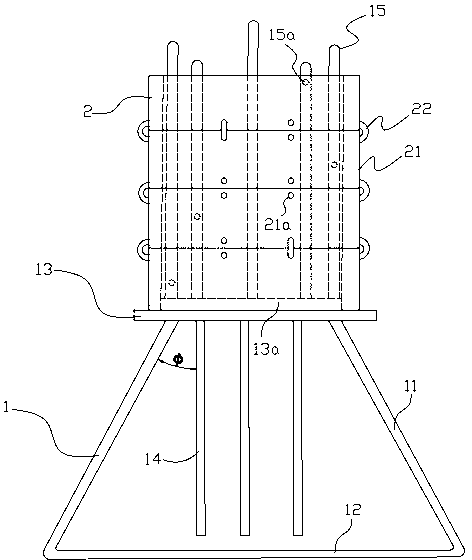Self-sinking fish reef proliferation method
A self-sinking, reef technology, applied in fish farming, applications, climate change adaptation, etc., can solve the problems of population density that can only be removed or destroyed, and low efficiency
- Summary
- Abstract
- Description
- Claims
- Application Information
AI Technical Summary
Problems solved by technology
Method used
Image
Examples
Embodiment
[0016] Example: refer to figure 1 , self-submerged fish reef multiplication method, it has the following steps:
[0017] 1. attach eggs: put the atoll 21 of the self-sinking fish reef into the waters where seedlings are abundant;
[0018] ②Transplanting: Combine the atoll 21 in step ① on the self-sinking fish reef device and put it into the sea area to be multiplied;
[0019] 3. population strengthening: inject seawater containing seaweed or shellfish seedlings into the multifunctional tube 15 of the self-sinking fish reef device of step 2;
[0020] 4. Variety change: as needed, inject saturated calcium hypochlorite solution through the multifunctional tube 15; carry out step 3. operation after one week; also can adopt other poisonous, low-residue chemical preparations that can kill aquatic animals. cannot be listed one by one.
[0021] The self-sinking fish reef has a self-sinking support 1; the self-sinking support 1 contains a platform 13; a trapezoidal support frame is ...
PUM
 Login to View More
Login to View More Abstract
Description
Claims
Application Information
 Login to View More
Login to View More - R&D
- Intellectual Property
- Life Sciences
- Materials
- Tech Scout
- Unparalleled Data Quality
- Higher Quality Content
- 60% Fewer Hallucinations
Browse by: Latest US Patents, China's latest patents, Technical Efficacy Thesaurus, Application Domain, Technology Topic, Popular Technical Reports.
© 2025 PatSnap. All rights reserved.Legal|Privacy policy|Modern Slavery Act Transparency Statement|Sitemap|About US| Contact US: help@patsnap.com

